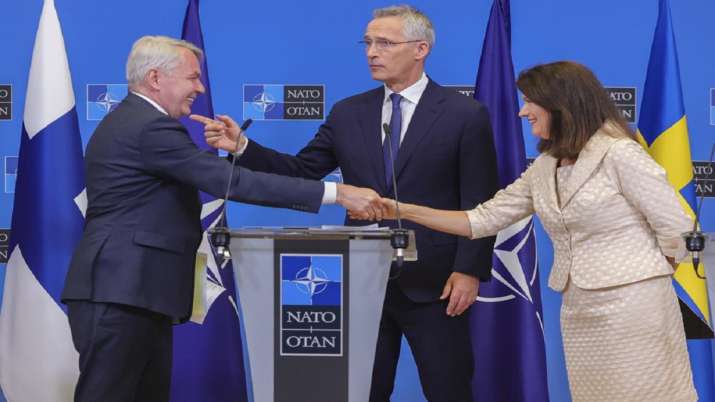
Finnish Foreign Minister Pekka Havisto, left, Swedish Foreign Minister Ann Linde, right, and NATO Secretary General Jens Stoltenberg attend a media conference following the signing of the NATO Accession Protocol for Finland and Sweden at NATO Headquarters in Brussels.
Highlight
- Accession increases Russia’s strategic isolation in the wake of its invasion of Ukraine
- Parliamentary acceptance by Turkey may still pose problems for eventual inclusion as members
- Permanent Representatives formally approve NATO’s decision to invite Finland and Sweden as members
30 NATO allies signed accession protocols for Sweden and Finland on Tuesday, sending the two countries’ membership bids to coalition capitals for legislative approval. The move adds to Russia’s strategic isolation in the wake of the February invasion of neighboring Ukraine and the military conflict since.
“This is truly a historic moment for Finland, for Sweden and for NATO,” said Coalition Secretary General Jens Stoltenberg. 30 ambassadors and permanent representatives formally approved the decisions of last week’s NATO summit after the coalition made the historic decision to invite Russia’s neighbor Finland and Scandinavian partner Sweden to join the military club.
Despite the agreement in the coalition, parliamentary approval in member state Turkey may still cause problems for their eventual inclusion as members. Last week, Turkish leader Recep Tayyip Erdogan warned that Ankara could still block the process if the two countries sought to extradite terrorist suspects with illegal Kurdish groups or a network of exiled clerics accused of a failed 2016 coup in Turkey. fail to fully meet the demand. turkey.
He said Turkey’s parliament could refuse to ratify the deal. This is a strong threat because NATO accession must be formally ratified by all 30 member states, giving each the right to blockade. Stoltenberg said he had no hope of a change of heart. “There were safety concerns that needed to be addressed. And we did what we always do in NATO. We got common land. ,
Each coalition nation has different legislative challenges and procedures to deal with, and it can take several more months for both to become official members. “I look forward to a speedy ratification process,” said Finnish Foreign Minister Pekka Havisto. The Russian invasion of Ukraine has given more urgency to the process. This would bring the two countries into a Western military alliance and further bolster NATO, especially in the face of Moscow’s military threat.
“We will be stronger and our people will be more secure as we face the biggest security crisis in decades,” Stoltenberg said. Tuesday’s signing has already brought the two countries under NATO. As close partners, they have already attended a few meetings that involved issues that immediately affected them. As official invitees, they can attend all meetings of ambassadors, even if they do not yet have any voting rights.
Read also | NATO member Turkey demands membership of coalition against Finland, Sweden
Read also | NATO invites Ukraine’s Zelensky to attend coalition summit in Madrid